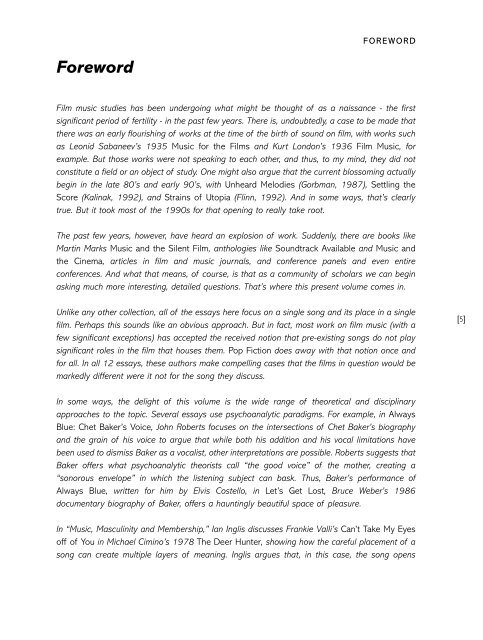You also want an ePaper? Increase the reach of your titles
YUMPU automatically turns print PDFs into web optimized ePapers that Google loves.
Foreword<br />
FOREWORD<br />
Film music studies has been undergoing what might be thought of as a naissance - the first<br />
significant period of fertility - in the past few years. There is, undoubtedly, a case to be made that<br />
there was an early flourishing of works at the time of the birth of sound on film, with works such<br />
as Leonid Sabaneev’s 1935 Music for the Films and Kurt London’s 1936 Film Music, for<br />
example. But those works were not speaking to each other, and thus, to my mind, they did not<br />
constitute a field or an object of study. One might also argue that the current blossoming actually<br />
begin in the late 80’s and early 90’s, with Unheard Melodies (Gorbman, 1987), Settling the<br />
Score (Kalinak, 1992), and Strains of Utopia (Flinn, 1992). And in some ways, that’s clearly<br />
true. But it took most of the 1990s for that opening to really take root.<br />
The past few years, however, have heard an explosion of work. Suddenly, there are books like<br />
Martin Marks Music and the Silent Film, anthologies like Soundtrack Available and Music and<br />
the Cinema, articles in film and music journals, and conference panels and even entire<br />
conferences. And what that means, of course, is that as a community of scholars we can begin<br />
asking much more interesting, detailed questions. That’s where this present volume comes in.<br />
Unlike any other collection, all of the essays here focus on a single song and its place in a single<br />
film. Perhaps this sounds like an obvious approach. But in fact, most work on film music (with a<br />
few significant exceptions) has accepted the received notion that pre-existing songs do not play<br />
significant roles in the film that houses them. Pop Fiction does away with that notion once and<br />
for all. In all 12 essays, these authors make compelling cases that the films in question would be<br />
markedly different were it not for the song they discuss.<br />
In some ways, the delight of this volume is the wide range of theoretical and disciplinary<br />
approaches to the topic. Several essays use psychoanalytic paradigms. For example, in Always<br />
Blue: Chet Baker’s Voice, John Roberts focuses on the intersections of Chet Baker’s biography<br />
and the grain of his voice to argue that while both his addition and his vocal limitations have<br />
been used to dismiss Baker as a vocalist, other interpretations are possible. Roberts suggests that<br />
Baker offers what psychoanalytic theorists call “the good voice” of the mother, creating a<br />
“sonorous envelope” in which the listening subject can bask. Thus, Baker’s performance of<br />
Always Blue, written for him by Elvis Costello, in Let’s Get Lost, Bruce Weber’s 1986<br />
documentary biography of Baker, offers a hauntingly beautiful space of pleasure.<br />
In “Music, Masculinity and Membership,” Ian Inglis discusses Frankie Valli’s Can’t Take My Eyes<br />
off of You in Michael Cimino’s 1978 The Deer Hunter, showing how the careful placement of a<br />
song can create multiple layers of meaning. Inglis argues that, in this case, the song opens<br />
[5]
















